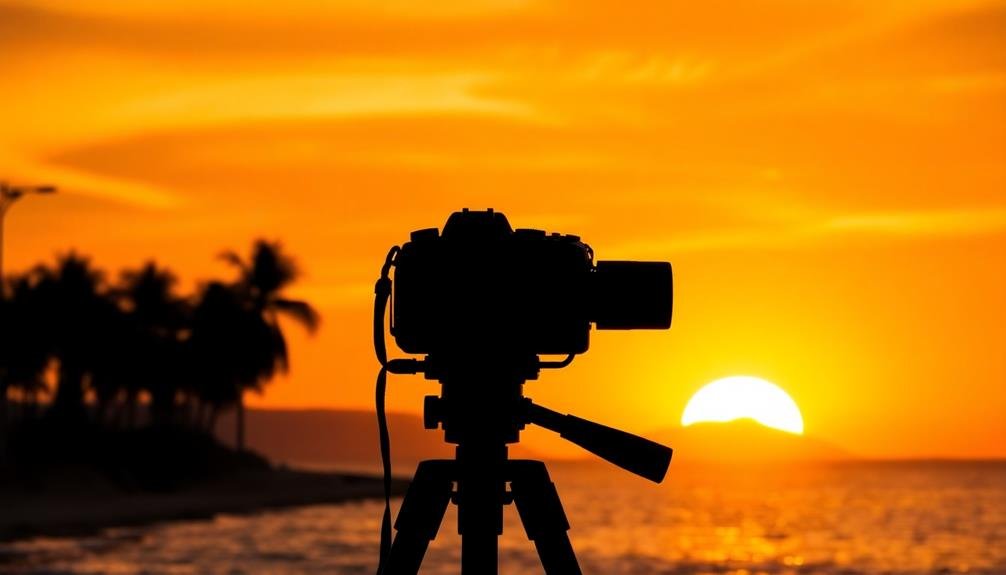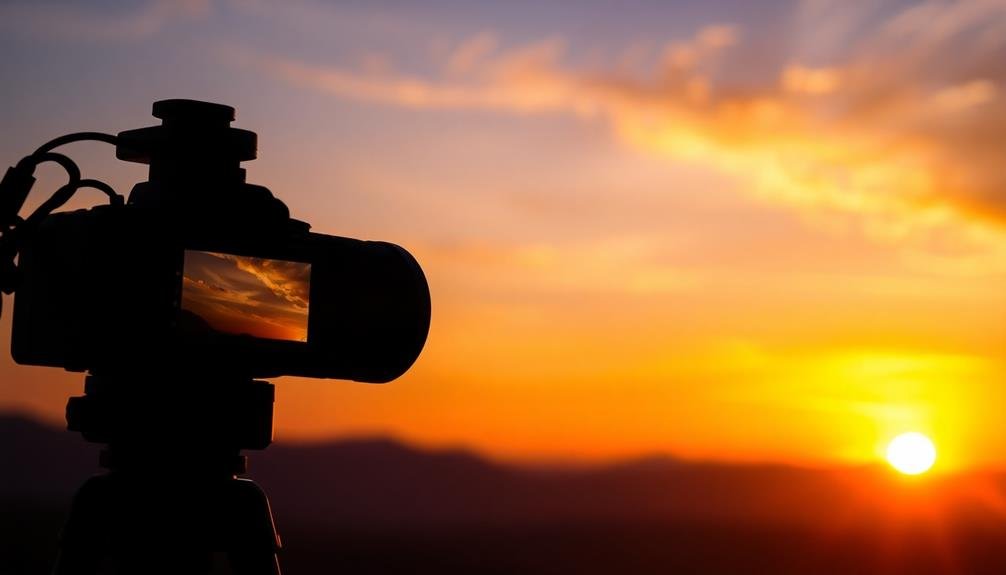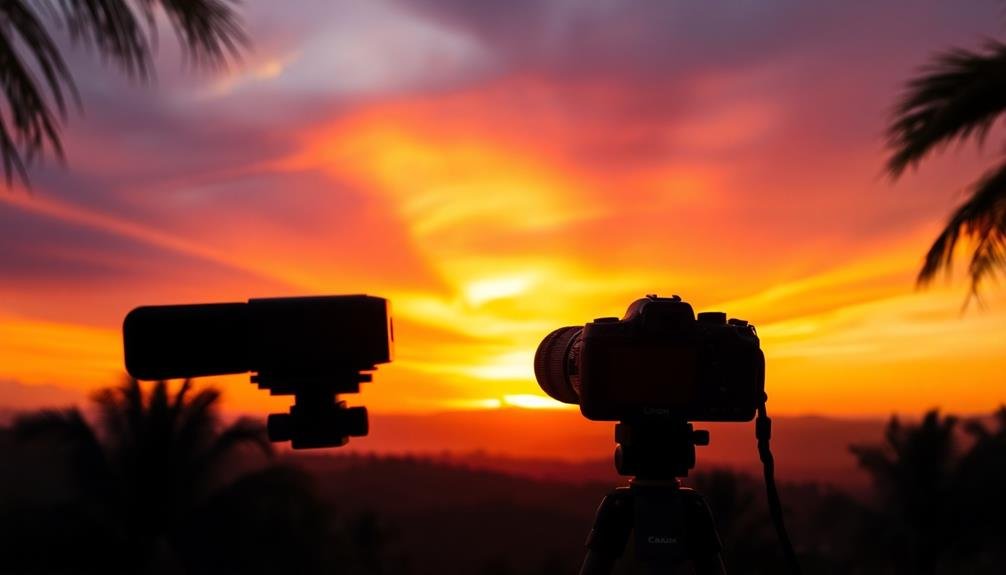To capture breathtaking sunset sky shots, master these three cinematography secrets. First, nail your golden hour timing by using apps to predict sunset times and arriving early to set up. Second, control dynamic range with HDR techniques or graduated neutral density filters to balance bright skies with darker foregrounds. Third, employ composition and movement techniques like the rule of thirds, leading lines, and slow pans to create visually compelling frames. Remember to stay for the afterglow and experiment with unconventional framing. By mastering these secrets, you'll elevate your sunset cinematography to new heights. Discover how these techniques can transform your sky shots into stunning masterpieces.
Golden Hour Timing

When it comes to capturing breathtaking sunset scenes, timing is everything. The golden hour, occurring shortly after sunrise or before sunset, offers filmmakers a magical window of opportunity. You'll want to be ready at least 30 minutes before the sun dips below the horizon to catch the full spectrum of colors.
To nail your golden hour timing, use smartphone apps that predict sunset times and golden hour duration for your specific location. Remember, these times vary depending on the season and your proximity to the equator. In summer, you'll have a longer golden hour, while winter offers a shorter, more intense window.
Don't pack up as soon as the sun disappears. The afterglow can provide some of the most stunning sky gradients. Stay alert for about 20-30 minutes after sunset to capture these fleeting moments.
For the best results, scout your location in advance and set up your equipment early. This way, you're not fumbling with gear when the perfect light arrives. Finally, be prepared to work quickly – the golden hour waits for no one, and conditions can change rapidly.
Dynamic Range Mastery

Three key principles underpin mastering dynamic range in sunset cinematography.
First, understand your camera's limitations. Each camera has a specific dynamic range capability, so it's essential to know how many stops of light yours can handle. This knowledge will help you make informed decisions about exposure and post-processing.
Second, embrace HDR techniques. High Dynamic Range imaging allows you to capture a wider range of luminosity than a single exposure. You can achieve this by bracketing your shots or using a camera with built-in HDR capabilities.
In post-production, you'll merge these exposures to create a balanced image that retains details in both highlights and shadows.
Finally, utilize graduated neutral density filters. These tools help balance the bright sky with the darker foreground, preventing overexposure of the sky or underexposure of the landscape.
Place the filter's dark portion over the sky, gradually shifting to clear at the horizon line.
Composition and Movement Techniques

Mastering dynamic range sets the stage for creating visually stunning sunset scenes, but it's the composition and movement techniques that truly bring your shots to life.
Start by applying the rule of thirds, placing key elements along the grid lines or at their intersections. This creates a balanced and visually appealing frame.
Consider using leading lines, such as a coastline or a road, to draw the viewer's eye towards the sunset. Incorporate foreground elements like silhouettes or reflections to add depth and interest.
Don't be afraid to experiment with unconventional framing, like using negative space to emphasize the sky's vastness.
For movement, try slow pans or tilts to reveal the landscape gradually. Use a slider for smooth lateral movements that showcase the changing colors.
Time-lapse techniques can capture the sun's descent and the sky's evolving palette dramatically. For handheld shots, use a stabilizer to maintain smoothness while adding a subtle organic feel.
Combine these techniques with careful timing. The golden hour just before sunset often provides the most enchanting light, while the blue hour after sunset offers a different, equally compelling mood.
Frequently Asked Questions
What Camera Filters Are Best for Enhancing Sunset Colors?
You'll want to use graduated neutral density filters to balance exposure and polarizing filters to enhance colors. Don't forget warming filters like 81A or 85B to intensify orange hues. Experiment with different combinations for stunning results.
How Do You Handle Rapidly Changing Light Conditions During Sunset Shoots?
You'll need to adapt quickly during sunset shoots. Adjust your camera settings frequently, use graduated ND filters, and shoot in RAW. Don't forget to bracket your exposures and keep an eye on your histogram for ideal results.
Are There Specific Weather Conditions That Produce the Most Dramatic Sunset Cinematography?
You'll find the most dramatic sunset shots when there's some cloud cover. Look for partly cloudy skies, especially with high cirrus clouds. They'll catch and reflect light beautifully, creating stunning colors and textures in your cinematography.
What Post-Processing Techniques Can Improve the Look of Sunset Footage?
You'll enhance your sunset footage with color grading, adjusting white balance, and boosting contrast. Don't forget to tweak highlights and shadows. You can also add subtle lens flares or vignettes for a more dramatic effect.
How Do You Safely Capture Sunset Shots in Challenging Locations or Terrains?
To safely capture sunset shots in challenging locations, you'll need to scout the area beforehand, bring proper gear, and wear appropriate clothing. Don't forget a headlamp, sturdy tripod, and emergency kit. Always inform someone of your plans.
In Summary
You've now revealed the secrets to stunning sunset cinematography. By mastering golden hour timing, understanding dynamic range, and perfecting composition and movement techniques, you'll capture breathtaking sky shots that'll leave your audience in awe. Remember, practice makes perfect. Don't be afraid to experiment with different settings and angles. As you refine your skills, you'll create cinematic masterpieces that showcase the sky's natural beauty in all its glory. Keep shooting and let your creativity soar!

As educators and advocates for responsible drone use, we’re committed to sharing our knowledge and expertise with aspiring aerial photographers.




Leave a Reply